|
US Landing Ship Tank 28
(US LST 28) on D Day.
Dog Red, Omaha Beach
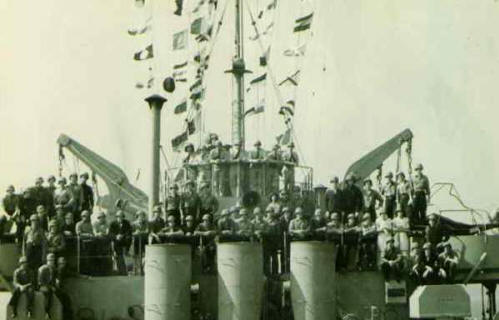 During World War II,
USS LST 28 was assigned to the European Theater
and saw action in North Africa and Normandy. She was
an
LST (1) Class Tank Landing Ship, laid down on 8/12/42 at Dravo
Corp, Pittsburgh, PA. She was launched on 19/4/43 and commissioned USS LST
28 on 19/6/43. During World War II,
USS LST 28 was assigned to the European Theater
and saw action in North Africa and Normandy. She was
an
LST (1) Class Tank Landing Ship, laid down on 8/12/42 at Dravo
Corp, Pittsburgh, PA. She was launched on 19/4/43 and commissioned USS LST
28 on 19/6/43.
Written
from material provided by
the late Wilson Earl Kelly. Full acknowledgement below.
[Photo; the crew of USS LST 28].
Joining the
US Navy
I
was working as a ship fitter at the Naval Shipyard in Norfolk, USA
when, on September 29, 1942, I volunteered for
US Navy Service using subterfuge to
circumvent Government regulations that
would have prevented me from doing so, because of the
importance of my job to the war effort.
If I followed the normal procedure in notifying
my employer of my '2-B' 'essential worker'
draft status, my application to volunteer for Navy service
would have been rejected. Consequently, when I received my 2-B notice in the summer of 1942,
I did not inform my employer as I was supposed to do.
As a result I was soon classified 1-A, which was a draft classification.
There was a risk that I might be
found out, so
I contacted Chris Bentz, the local Navy Recruiter and he promised me a
3/c ship fitter’s rating in the US Navy. I signed up on September 29th,
1942, accompanied by my wife Martha.
We said our goodbyes at the recruiting office,
since it would be quite some time before I qualified for
leave.
Initial Posting
The next night I was back home in Norfolk, in
uniform! The skills I had were in such demand
in the Navy that, the
following day, I was posted directly into service
without attending boot camp for basic training. Although the world was to become my oyster, I
started my naval career in Little
Creek, next door to the naval shipyard I had worked in as a civilian.
At the time, Little Creek was a
quagmire of a building site that would become an
amphibious base.
Tarpaper lined wooden shacks masquerading as the more substantial and comfortable Quonset
huts (the North American equivalent of British Jimmy the One
huts) became our home. Each hut was approximately 100 feet long and 20 feet
wide and heated by two wood/coal
burning stoves, which required
feeding during the night to keep reasonably warm. This
usually fell on the
security detail,
who were awake anyway. The huts were arranged in groups of four with a washroom, showers and
laundry room in a nearby hut.
 The strategic planners knew that an amphibious
invasion force of overwhelming
power would be required
to establish and hold a large beachhead against the enemy's
entrenched coastal defences on mainland Europe. Since
there would be no convenient harbours, the invasion force would be landed
directly on to unimproved landing beaches. The size of
the task ahead in the USA and the UK was, therefore, almost beyond
comprehension. Thousands of landing craft of many different types and sizes had
to be designed and constructed and many hundreds of thousands of troops, the
navy crews to man the craft and the air crews to provide support and cover,
required training both separately and together as a combined force. The strategic planners knew that an amphibious
invasion force of overwhelming
power would be required
to establish and hold a large beachhead against the enemy's
entrenched coastal defences on mainland Europe. Since
there would be no convenient harbours, the invasion force would be landed
directly on to unimproved landing beaches. The size of
the task ahead in the USA and the UK was, therefore, almost beyond
comprehension. Thousands of landing craft of many different types and sizes had
to be designed and constructed and many hundreds of thousands of troops, the
navy crews to man the craft and the air crews to provide support and cover,
required training both separately and together as a combined force.
Dozens of landing craft designs
emerged as particular needs
were identified. For example LCV(P)s
(Landing Craft Vehicle Personnel) were 36 feet
long, LCMs (Landing Craft Mechanised) were 50 feet
long and LSTs (Landing Ship Tanks) were 300 foot
long. There was a mountain to climb, since many
rookies could hardly get their flat bottomed craft into the docks without causing
damage. It was clear where my welding and plating skills would be most in
demand - patching plates over holes in the
hulls. The repairs were pretty rough and ready, because further damage in the
same vulnerable areas was almost a certainty. All in all it wasn't a bad duty.
While I stayed at the amphibious base in Little Creek during this period,
Martha
moved to Ocean View, a suburb of the town. Whenever I wasn't on duty I would ease
on down there but this cosy arrangement ended
abruptly on March 26, 1943, when my temporary ship's duty
expired. I was in the draft and due to be shipped out. There
was no notice or general warning. I
was told, unceremoniously, to pack my sea bag and go. I left my car and
various goods and chattels behind. I phoned my mates at the Army base at Bradford to
pick my car up but could tell them nothing about my
destination, because I didn't know myself. Secrecy was paramount during the war and only those who needed to know
were informed in advance of our destination.
 Training
and Work-Up Training
and Work-Up
In the event I was shipped out to Solomons,
Maryland to an organizing base for
the crews of LSTs. All the crews needed to operate,
repair and service their landing
craft and, initially, we were
allowed to get acquainted and to
go through training. This included some drilling or 'square bashing' and
training in the operation of LSTs, including seamanship, beaching, retraction from the beach,
loading and unloading procedures, firefighting, maintenance procedures and so
on. This was the only time during my service that I
undertook any marching drill, which I stumbled
through, almost literally! About a month later we were 'shipped' by bus to
Washington and then by troop train to Panama City, Florida.
We arrived there on May 10, 1943, after two days on a very dirty and
slow troop train pulled by an obsolete engine, which had been brought back into
service after retirement. This
was a new part of the USA for me... Florida! It was May and beautiful.
We were assigned to LST 202 to
give novice crews
'hands on' experience under supervision, while they waited for their own ship to
be completed. This posting lasted for
the duration of the trip back up to
Norfolk. On June 10, 1943, we arrived at Coraopolis,
Pennsylvania and boarded the
recently commissioned LST 28, which
was to be my home for some time. She was built by the Dravo Corporation at
Neville Island, just outside Pittsburgh. With a special skeleton crew, who knew the Ohio River,
we sailed to the Mississippi
river and made our way down the river picking up pilots on the way
as required.
It was a beautiful trip which I
really enjoyed.
On reaching New Orleans, we tied up in an amphibious base called Algiers.
As usual we were not told our destination but the color of the
camouflage told us which theater we were destined for. Those painted in a light and dark green mottled effect were destined
for the South Pacific, while others painted in three
shades of blue/grey were destined for Europe. A good
friend's ship was painted green and mine was blue. We were heading in different
directions. With a limited crew we brought her up to Norfolk. I
think her armaments included a 5.38mm and, at the stern, four 40mms,
although these may have been later replacements for 20 mm anti aircraft guns.
North
Africa
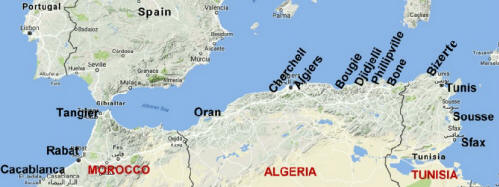 We left Norfolk in early March 1944, for Europe. The ships travelled across
the Atlantic in convoy. It was not unusual for LSTs and other slower vessels to
be escorted by Destroyers and even a submarine or two on occasions. U Boat attacks
were a constant threat as the LSTs transported crew and material across
the Atlantic ocean. It took us 30 days to reach our
final destination in Africa. We left Norfolk in early March 1944, for Europe. The ships travelled across
the Atlantic in convoy. It was not unusual for LSTs and other slower vessels to
be escorted by Destroyers and even a submarine or two on occasions. U Boat attacks
were a constant threat as the LSTs transported crew and material across
the Atlantic ocean. It took us 30 days to reach our
final destination in Africa.
Our first
planned landing was at Bizerte, Tunisia but, on April 1,
while off Algiers, we had our first taste of action, as German planes
from Laissez in France attacked at about four o’clock in the morning.
General quarters
sounded. In no time I was at my station at the bow of the ship,
where I took charge of the 'repair gang.'
The Commissioned Officer was in overall command
and took direct control of half of the Damage Control Party,
while the other half was usually supervised by a
subordinate officer who reported to the Commissioned Officer. On this occasion,
I had the other half as the leading Petty Officer forward.
The crew of our ship and the others nearby were
soon on deck with their guns firing skyward. The
planes and bombs were invisible to us, although the explosions were all too
obvious. The Germans hit a tanker, setting it on fire. With all the destruction I saw
and the very hazardous position we were in, I
felt a bit wobbly in the knees. This initial reaction was not uncommon but
we soon rose above it as our training kicked in.
There was the odd person who panicked under the stress of it all and failed
to man their station. One such was a crew member of an LCT we were carrying. He
was supposed to man a gun but chose instead to hide under it. This was, however, an isolated instance.
We
didn’t receive a direct hit, just fragments of spent shells
fired by other ships and no
one was badly hurt. A couple of days later, when we arrived at Bizerte, one of our
ships proudly displayed a swastika up on
their Conn, as though they had shot down one of the German planes. The truth was
that the pilot flew too low, hit their mast and crashed into the sea!
Tunis was about 20 miles from
Bizerte. It had changed hands about four times in the war and was bombed
and shelled on each occasion. There was scarcely a building with an
intact roof but, despite the devastation, it was easy to see it had once
been a beautiful city. We were loaded with ammunition packaged in cartons on the tank deck,
all
kinds. If we took a direct hit with
this cargo, there wouldn’t be anything left of us or the craft.
 We
unloaded at Bizerte and embarked tanks for the Anzio beachhead
in Italy. We unloaded at Nettuno to the east of Anzio and made our way to Oran
with a disabled LCT in tow. The LCT rammed a couple of holes in our stern in
the rough weather. I later
repaired the damage. We
unloaded at Bizerte and embarked tanks for the Anzio beachhead
in Italy. We unloaded at Nettuno to the east of Anzio and made our way to Oran
with a disabled LCT in tow. The LCT rammed a couple of holes in our stern in
the rough weather. I later
repaired the damage.
It was the 15th of April,1944, when we set off for England – Merry Old
England! We carried French Provincial Sailors from Oran, who were destined to
join a Tank Corps and to link up with other Free French forces in England. The
journey from North Africa was very rough once we entered the
Atlantic on leaving Gibraltar. The
smell of the heavy diesel fuel that powered the ship
was, by itself, very unpleasant but the combination of
the two was nauseating. We were all affected by
severe sea sickness but the French contingent more so than others. We arrived at Swansea in South Wales
on the 3rd of May and on the 4th we tied up in
nearby Cardiff.
We had no idea that we were
shortly to be part of the largest amphibious invasion force in history.
We travelled to various ports along the south coasts of
Wales and England, taking in Swansea, Cardiff, Milford Haven
(21st May), Falmouth (26th May), Southampton and Plymouth.
D-Day
and its Aftermath
And so the day arrived… D-Day, the 5th of June,
1944. We embarked 500
soldiers aboard our little LST. This done, the ship was sealed
for security reasons, which meant there was no hot food
available for the troops. There was,
however, a mountain of corned beef hash cans on the deck,
which they could eat to their heart's content. We had one cook, who
could prepare hot food for
about 40 but feeding
500 soldiers was quite impossible. For the
most part, we had K Rations. C Rations were available but these needed to be
heated. Our Skipper, by the name of Findley from Baltimore, decided
that we, the crew, would eat the same food as the soldiers we carried. I suppose that was fair enough but, as soon as we unloaded
them, we got back to hot chow! The soldiers' prospects of hot meals were pretty
remote in the short term. Skipper, by the name of Findley from Baltimore, decided
that we, the crew, would eat the same food as the soldiers we carried. I suppose that was fair enough but, as soon as we unloaded
them, we got back to hot chow! The soldiers' prospects of hot meals were pretty
remote in the short term.
[Extract from the Admiralty's 'Green List'
showing the disposition of Force B of the US Eleventh Amphibious Force, which
includes US LST 28].
We
made ready to leave the harbor at Weymouth on June 5th at about two o'clock.
However, we never left it for the open sea, because the
whole invasion had been pushed back by 24 hours because of
bad weather.
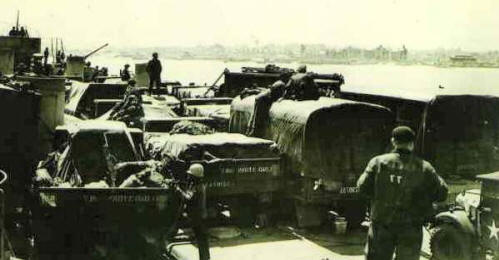 We
had to live in these
cramped conditions for a further 24 hours but,
somehow, we all survived. Poker and crap games sprung
up all over the ship. The next morning we set off once more but this time
for Normandy. We
had to live in these
cramped conditions for a further 24 hours but,
somehow, we all survived. Poker and crap games sprung
up all over the ship. The next morning we set off once more but this time
for Normandy.
[The 1st of 3 Photos; departure and crossing of the English Channel].
We
were part of the US Eleventh Amphibious Force, Force 'B' of Division 23 and took our place in line with our Flotilla. It was an overcast, grey morning but, as it got lighter,
the most awesome sight I have ever seen came into view. From
high up in the Conn I could see a vast armada of ships
as far as the eye could see! If the thousands of ships
were placed end to end, I think you
could have walked to France that day!
A medical team
was aboard, since we were designated
as a medical ship to take casualties off the beach and
return them to England for hospital
treatment. The medical team comprised four doctors and about sixteen
medics - Army medics and Navy hospital Corpsmen stationed with us. One of the Doctors
took pictures continuously of the whole proceeding, despite
being forbidden for security reasons. While I didn't
take photos I did keep a notice from Admiral Cook,
which was issued to all of the ships under his command. It should have been
destroyed but it made a nice souvenir
and was of no value to
the enemy.
 We
were detailed to go to Dog Red landing area on Omaha
beach. There were 5 landing beaches codenamed Utah, Omaha, Juno, Sword and Gold. Americans landed at Utah and Omaha and the British and
Canadians at the others. At the initial landing, Omaha turned out to be the
toughest and with little progress through the beachhead, men
and vehicles just bottled up on the
beach. I think
they ran into a German Panzer Division that just happened to be in that Sector. We
were detailed to go to Dog Red landing area on Omaha
beach. There were 5 landing beaches codenamed Utah, Omaha, Juno, Sword and Gold. Americans landed at Utah and Omaha and the British and
Canadians at the others. At the initial landing, Omaha turned out to be the
toughest and with little progress through the beachhead, men
and vehicles just bottled up on the
beach. I think
they ran into a German Panzer Division that just happened to be in that Sector.
Unable to disembark our cargo of men,
we moved about three-quarters of a mile offshore
to await further instructions. We came under
shell fire, most likely from
the ubiquitous 88s. So long as the initial assault troops remained pinned down,
everything behind them was piling up as wave upon wave
of new arrivals and supplies rolled in. We were, perhaps, at
the outer range of the German guns, since only a few landed close by but an LCI, closer in than we were,
was hit.
We
stood by for hours while our cargo
was transferred onto a Rhino Ferry -
a large, flat floating barge with
a powerful outboard engine. We
took great care in transferring the tanks, since the slightest error
would send the tank to the sea-bed. One of our small
boats hit a mine and was lost but we never heard if there
were any survivors.
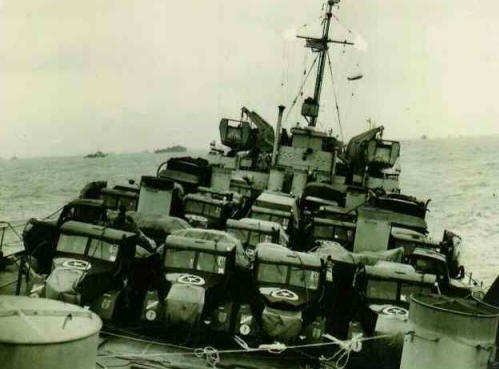 Once we unloaded, we steamed
to Southampton without delay, where we loaded up again and
immediately returned to Normandy as
part of another convoy. The route of about
seventy-five miles, including
zig-zagging to confuse any marauding submarines,
usually took about 12 hours. This second trip was also to Omaha, which by then
(D-Day+1) was a little quieter but still hazardous. We beached without incident, unloaded and got off real fast. Once we unloaded, we steamed
to Southampton without delay, where we loaded up again and
immediately returned to Normandy as
part of another convoy. The route of about
seventy-five miles, including
zig-zagging to confuse any marauding submarines,
usually took about 12 hours. This second trip was also to Omaha, which by then
(D-Day+1) was a little quieter but still hazardous. We beached without incident, unloaded and got off real fast.
On June the 9th, we arrived
in Portland after our second trip. On the way,
German E boats (small, fast torpedo boats) hit a
couple of vessels. Danger was not confined to enemy action, as we found out when
we were almost rammed by
LST 331 in what were very congested waters. It was
about 9 pm and our attention was distracted by a big air attack.
Anyway, we brought back 24 wounded and there was one
German POW. On another trip we had so many German POWs
that they covered the whole tank deck!
On June 14 we returned to
the Omaha beachhead, this time in convoy with
just four LSTs, having missed the regular main convoy.
Before we had completed unloading our cargo, we became
stranded on the beach as the tide
went out. This was not an uncommon predicament, as craft were often not
unloaded and re-floated on the same tide. Fortunately the
Allies had air supremacy, so enemy attacks were much lighter than anticipated.
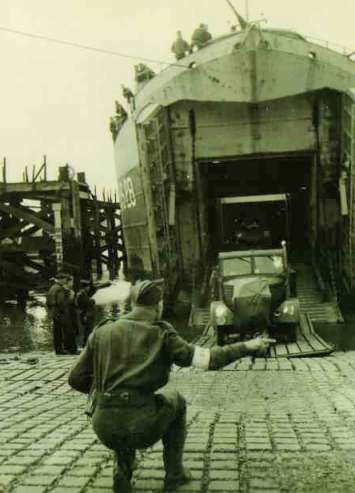 There was a menu of measures
to help disembark our heavy tanks in difficult conditions. If a particular
landing area was unable to carry the weight of tanks and heavy lorries, the
Engineering Corps would construct a 'hard',
or concrete
platform, onto which our ramp was lowered.
For less serious situations, pontoons and landing mats
were used as a temporary fix. Beaching could be very
tricky when there were strong tides, coastal currents and
strong winds. In
all circumstances we tried to carefully nose in and, once secure on the
landing beach, to off-load the vehicles by driving them forwards, the vehicles having been
reversed into position on loading. There was a menu of measures
to help disembark our heavy tanks in difficult conditions. If a particular
landing area was unable to carry the weight of tanks and heavy lorries, the
Engineering Corps would construct a 'hard',
or concrete
platform, onto which our ramp was lowered.
For less serious situations, pontoons and landing mats
were used as a temporary fix. Beaching could be very
tricky when there were strong tides, coastal currents and
strong winds. In
all circumstances we tried to carefully nose in and, once secure on the
landing beach, to off-load the vehicles by driving them forwards, the vehicles having been
reversed into position on loading.
We did experience a number of air attacks,
when we felt very vulnerable stuck on the
beachhead, sometimes until the next tide. On one occasion I saw a
number of wrecked LCTs and LCIs, as if to prove the point. I didn’t see any
seriously damaged vessels of our type but we heard that an LST
hit a mine off the English coast. It struck toward the aft end of the ship,
causing sixty fatalities and many more wounded casualties.
Mine sweeping remained a top priority during this period
of intense movement across the English Channel and the minesweepers worked continually but couldn’t
guarantee to recover all the mines. It's my
understanding that many of these mines were dropped by German planes.
By June 24th
we made a trip to a British beachhead.
This was 18 days after D-Day and the front line was still
only six miles inland, since it was proving difficult to dislodge the Germans in
Caen. We were constantly shelled from behind the
front line and two LSTs 499 and 133
were sunk. One may have been salvaged, since I saw engineers working on
it. We had a barrage balloon tied to our craft to deter low flying
enemy air attacks. However, the enemy heavy guns
that were shelling us may have used it for range finding, so the Skipper let
it go. In any event low level strafing
was not really a problem.
Postscript by
James Edwards, Electrician's
Mate
LST 28 continued it's service in the ensuing months with many supply
runs to the Normandy beaches and taking wounded and prisoners back to England. In time, the demand
for landing craft shifted to the war in the Pacific and
LST 28 received orders to return to New York for re-fitting. All Officers and crew were
given leave and replaced with a new crew complement.
The new crew prepared themselves and the ship for the invasion of Japan.
The 3" stern gun was removed and replaced with dual 40mm guns, which had a
'new' electric control. The bow gun was replaced and all
equipment was refurbished and reconditioned.
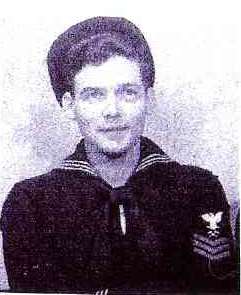 The ship was moved to New Jersey, where the hull
was painted in Pacific theatre camouflage. After
approximately three months of work, stores, supplies,
cargo and munitions were taken on board. However, atomic bombs were dropped at Hiroshima and Nagasaki
and the war came to an abrupt end. The entire world went
wild. On board ship, the air was filled with the sound of horns and bells
from LST 28 itself and others ships in the vicinity. The ship was moved to New Jersey, where the hull
was painted in Pacific theatre camouflage. After
approximately three months of work, stores, supplies,
cargo and munitions were taken on board. However, atomic bombs were dropped at Hiroshima and Nagasaki
and the war came to an abrupt end. The entire world went
wild. On board ship, the air was filled with the sound of horns and bells
from LST 28 itself and others ships in the vicinity.
I had a problem after the war
ended. The new Skipper said I had to have a replacement electrician's mate
before I could go home. Since I was the last electrician on board at that
point, every day I would ask every man coming aboard "Do you know anything
about electricity or batteries?" It seemed a long time waiting. One day a
young boy came on board and to my surprise he said, "I worked in a filling
station and know a little about batteries - how to charge them." I virtually dragged him into the
Skipper's office and asked, "When can I go home?" It wasn't long after that
when I was sent to Oklahoma and discharged.
LST 28 later returned to the
shipyard in New York and was re-painted ship blue.
After a short period of inactivity, she was decommissioned on 16/8/46, struck from the Naval Register
on 29/10/46 and sold for scrapping on 19/5/48 to George H. Nutman,
Brooklyn, NY. USS LST
28 earned two battle stars for World War II
service.
Further Reading
On this
website there are around 50 accounts of
landing craft training and
operations and landing craft
training establishments.
There are around 300 books listed on our 'Combined Operations Books' page which can
be purchased on-line from the Advanced Book Exchange (ABE) whose search
banner checks the shelves of thousands of book shops world-wide. Type in or
copy and paste the title of your choice or use the 'keyword' box for book
suggestions. There's no obligation to buy, no registration and no passwords.
Click 'Books' for more
information.
Full specification of USS LST 28 at
NavSource.
Acknowledgments
Written by Geoff Slee from material provided
by the late Wilson Earl Kelly, SF1c
with additional information from James Edwards,
Electrician's Mate. Photos, maps and an extract from the
Admiralty's "Green List" of landing craft dispositions just prior to D-Day
have been added for illustrative purposes.
|










 The ship was moved to New Jersey, where the hull
was painted in Pacific theatre camouflage. After
approximately three months of work, stores, supplies,
cargo and munitions were taken on board. However, atomic bombs were dropped at Hiroshima and Nagasaki
and the war came to an abrupt end. The entire world went
wild
The ship was moved to New Jersey, where the hull
was painted in Pacific theatre camouflage. After
approximately three months of work, stores, supplies,
cargo and munitions were taken on board. However, atomic bombs were dropped at Hiroshima and Nagasaki
and the war came to an abrupt end. The entire world went
wild
